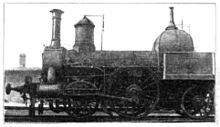Saxon VIa
| Via | |
|---|---|
| Number: | 43 |
| Manufacturer: |
Borsig Hartmann , Chemnitz |
| Commissioning: | 1848-1868 |
| Retirement: | 1890-1902 |
| Axis formula : | 1A1 |
| Length over buffers: | k. A. |
| Driving wheel diameter: | 1,830 mm |
| Impeller diameter (front): | 1,200 mm |
| Impeller diameter (rear): | 1,200 mm |
| Top speed: | k. A. |
| Boiler overpressure: | 7.5 bar |
| Piston stroke: | 508 mm / 560 mm |
| Cylinder diameter : | 381 mm / 380 mm |
| Grate area: | 1.0 m² |
| Evaporation heating surface: | 87.1 m² |
| indicated performance: | k. A. |
| Axle travel mass: | 11.8 t |
| Friction mass: | 11.8 t |
| Service mass: | 28.0 t |
| Brake design : | k. A. |
As a genus VIa designated Royal Saxon State Railways different types of express train - locomotives , which originally from the Leipzig-Dresden Railway and the Eastern State Railway came.
history


Between 1848 and 1868, the Leipzig-Dresden Railway built 40 locomotives for fast passenger traffic on the route between Leipzig and Dresden, and the Eastern State Railway built three locomotives for the Dresden – Bodenbach line in 1861/62 . At the Kgl. Saxon State Railways, all uncoupled locomotives were grouped under the class _ VIa . The manufacturer's abbreviation was used in place of the _ until 1896 (it was then omitted without replacement), class VI comprised so-called express train locomotives and a stood for older types, in this case for the uncoupled machines with a 1 A 1 wheel arrangement.
With the establishment of K. Sächs. Sts. EB 1869 were initially only the three H artmann - locomotives of the Eastern State Railways in their stock. From 1871 they were listed as class H VI a.
The Leipzig-Dresden Railway had withdrawn the first eight of its locomotives (the Borsig and Hartmann deliveries of the years 1848/49) by 1868 and the four following locomotives from the Borsig delivery of 1854 in the years 1873/76 in B 1 tender or tender. B 1 tank locomotives rebuilt. These early machines had significantly different dimensions than the later ones. The 28 remaining from 1856-1868 H artmann or B orsig machines built received by socialization of LDE 1876, the generic H VIa or B VIa , the modifications were as B II or B IIa T out.
The so-called "spinning wheels" lasted a surprisingly long time. In 1890, with 21 machines, almost half of the original stock was still in operation. In recent years they have mainly been used in passenger train service. The last to be retired was track number 6, formerly GUSTAV HARKORT , in 1902 .
The track number 2, former BOEHLEN (formerly ZÜRICH of the LDE) was eliminated as the penultimate in 1900. In 1901 it was restored to the state it was in when it was taken over by the State Railways and was intended for the Saxon Railway Museum. It was nevertheless scrapped around 1925.
technical features
The locomotives had an internal sheet metal frame and, apart from the three engines of the Eastern State Railroad, a Kirchweger exhaust steam condenser. The slide control was either Borsig or Stephenson. The locomotives also had different types of boiler. Most of the locomotives were delivered without cabs.
literature
Lothar Spielhoff: Länderbahn steam locomotives. Volume 1: Prussia, Mecklenburg, Oldenburg, Saxony and Alsace-Lorraine . Franckh'sche Verlagshandlung, Stuttgart 1990, ISBN 3-440-06145-0 .
